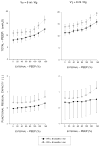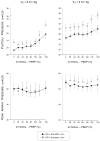Paradoxical responses to positive end-expiratory pressure in patients with airway obstruction during controlled ventilation
- PMID: 16003057
- PMCID: PMC2287196
- DOI: 10.1097/01.ccm.0000168044.98844.30
Paradoxical responses to positive end-expiratory pressure in patients with airway obstruction during controlled ventilation
Abstract
Objective: To reevaluate the clinical impact of external positive end-expiratory pressure (external-PEEP) application in patients with severe airway obstruction during controlled mechanical ventilation. The controversial occurrence of a paradoxic lung deflation promoted by PEEP was scrutinized.
Design: External-PEEP was applied stepwise (2 cm H(2)O, 5-min steps) from zero-PEEP to 150% of intrinsic-PEEP in patients already submitted to ventilatory settings minimizing overinflation. Two commonly used frequencies during permissive hypercapnia (6 and 9/min), combined with two different tidal volumes (VT: 6 and 9 mL/kg), were tested.
Setting: A hospital intensive care unit.
Patients: Eight patients were enrolled after confirmation of an obstructive lung disease (inspiratory resistance, >20 cm H(2)O/L per sec) and the presence of intrinsic-PEEP (> or =5 cm H(2)O) despite the use of very low minute ventilation.
Interventions: All patients were continuously monitored for intra-arterial blood gas values, cardiac output, lung mechanics, and lung volume with plethysmography.
Measurements and main results: Three different responses to external-PEEP were observed, which were independent of ventilatory settings. In the biphasic response, isovolume-expiratory flows and lung volumes remained constant during progressive PEEP steps until a threshold, beyond which overinflation ensued. In the classic overinflation response, any increment of external-PEEP caused a decrease in isovolume-expiratory flows, with evident overinflation. In the paradoxic response, a drop in functional residual capacity during external-PEEP application (when compared to zero-external-PEEP) was commonly accompanied by decreased plateau pressures and total-PEEP, with increased isovolume-expiratory flows. The paradoxic response was observed in five of the eight patients (three with asthma and two with chronic obstructive pulmonary disease) during at least one ventilator pattern.
Conclusions: External-PEEP application may relieve overinflation in selected patients with airway obstruction during controlled mechanical ventilation. No a priori information about disease, mechanics, or ventilatory settings was predictive of the response. An empirical PEEP trial investigating plateau pressure response in these patients appears to be a reasonable strategy with minimal side effects.
Figures





Comment in
-
Positive end-expiratory pressure in severe airflow obstruction: more than a "one-trick pony"?Crit Care Med. 2005 Jul;33(7):1652-3. doi: 10.1097/01.ccm.0000170181.59277.95. Crit Care Med. 2005. PMID: 16003082 No abstract available.
-
In patients with obstructive pulmonary disease during controlled ventilation, PEEP decreases dynamic hyperinflation: is this response really "paradoxical"?Crit Care Med. 2005 Dec;33(12):2860. doi: 10.1097/01.ccm.0000191255.77119.a2. Crit Care Med. 2005. PMID: 16352983 No abstract available.
References
-
- Fleury B, Murciano D, Talamo C, et al. Work of breathing in patients with chronic obstructive pulmonary disease in acute respiratory failure. Am Rev Respir Dis. 1985;131:822–827. - PubMed
-
- Marini JJ. Should PEEP be used in airflow obstruction? Am Rev Respir Dis. 1989;140:1–3. - PubMed
-
- Marini JJ. Strategies to minimize breathing effort during mechanical ventilation. Crit Care Clin. 1990;6:635–662. - PubMed
-
- Marini JJ. Patient-ventilator interaction: Rational strategies for acute ventilatory management. Respir Care. 1993;38:482–493.
-
- Petrof BJ, Calderini E, Gottfried SB. Effect of CPAP on respiratory effort and dyspnea during exercise in severe COPD. J Appl Physiol. 1990;69:179–188. - PubMed
Publication types
MeSH terms
Grants and funding
LinkOut - more resources
Full Text Sources
Medical

